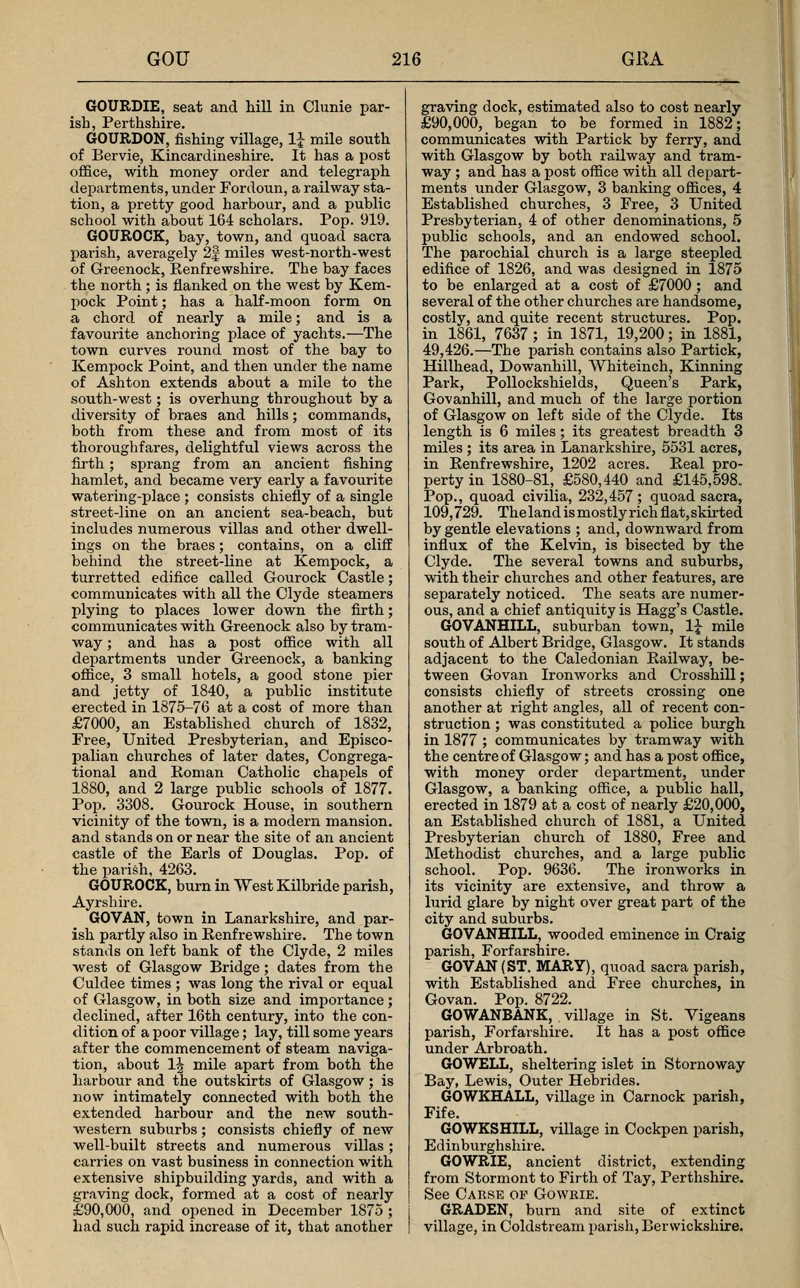GOURDIE, seat and hill in Clunie parish, Perthshire.
GOURDON, fishing village, 1J mile south of Bervie, Kincardineshire. It has a post office, with money order and telegraph departments, under Fordoun, a railway station, a pretty good harbour, and a public school with about 164 scholars. Pop. 919.
GOUROCK, bay, town, and quoad sacra parish, averagely 2f miles west-north-west of Greenock, Renfrewshire. The bay faces the north ; is flanked on the west by Kempock Point ; has a half-moon form on a chord of nearly a mile ; and is a favourite anchoring place of yachts. The town curves round most of the bay to Kempock Point, and then under the name of Ashton extends about a mile to the south-west ; is overhung throughout by a diversity of braes and hills; commands, both from these and from most of its thoroughfares, delightful views across the firth ; sprang from an ancient fishing hamlet, and became very early a favourite watering-place ; consists chiefly of a single street-line on an ancient sea-beach, but includes numerous villas and other dwellings on the braes ; contains, on a cliff behind the street-line at Kempock, a turretted edifice called Gourock Castle ; communicates with all the Clyde steamers plying to places lower down the firth ; communicates with Greenock also by tram-way ; and has a post office with all departments under Greenock, a banking office, 3 small hotels, a good stone pier and jetty of 1840, a public institute erected in 1875-76 at a cost of more than 7000, an Established church of 1832, Free, United Presbyterian, and Episcopalian churches of later dates, Congregational and Roman Catholic chapels of 1880, and 2 large public schools of 1877. Pop. 3308. Gourock House, in southern vicinity of the town, is a modern mansion, and stands on or near the site of an ancient castle of the Earls of Douglas. Pop. of the parish, 4263.
GOUROCK, burn in "West Kilbride parish, Ayrshire.
GOVAN, town in Lanarkshire, and parish partly also in Renfrewshire. The town stands on left bank of the Clyde, 2 miles west of Glasgow Bridge ; dates from the Culdee times ; was long the rival or equal of Glasgow, in both size and importance ; declined, after 16th century, into the condition of a poor village ; lay, till some years after the commencement of steam navigation, about 1 mile apart from both the harbour and the outskirts of Glasgow ; is now intimately connected with both the extended harbour and the new south-western suburbs; consists chiefly of new well-built streets and numerous villas ; carries on vast business in connection with extensive shipbuilding yards, and with a graving dock, formed at a cost of nearly 90,000, and opened in December 1875 ; had such rapid increase of it, that another graving dock, estimated also to cost nearly 90,000, began to be formed in 1882; communicates with Partick by ferry, and with Glasgow by both railway and tram-way ; and has a post office with all departments under Glasgow, 3 banking offices, 4 Established churches, 3 Free, 3 United Presbyterian, 4 of other denominations, 5 public schools, and an endowed school. The parochial church is a large steepled edifice of 1826, and was designed in 1875 to be enlarged at a cost of 7000 ; and several of the other churches are handsome, costly, and quite recent structures. Pop. in 1861, 7637; in 1871, 19,200; in 1881, 49,426. The parish contains also Partick, Billhead, Dowanhill, Whiteinch, Kinning Park, Pollockshields, Queen's Park, Govanhill, and much of the large portion of Glasgow on left side of the Clyde. Its length is 6 miles ; its greatest breadth 3 miles ; its area in Lanarkshire, 5531 acres, in Renfrewshire, 1202 acres. Real property in 1880-81, 580,440 and 145,598. Pop., quoad civilia, 232,457 ; quoad sacra, 109,729. The land is mostly rich flat, skirted by gentle elevations ; and, downward from influx of the Kelvin, is bisected by the Clyde. The several towns and suburbs, with their churches and other features, are separately noticed. The seats are numerous, and a chief antiquity is Hagg's Castle.
GOVANHILL, suburban town, 1 mile south of Albert Bridge, Glasgow. It stands adjacent to the Caledonian Railway, be-tween Govan Ironworks and Crosshill ; consists chiefly of streets crossing one another at right angles, all of recent construction ; was constituted a police burgh in 1877 ; communicates by tramway with the centre of Glasgow; and has a post office, with money order department, under Glasgow, a banking office, a public hall, erected in 1879 at a cost of nearly 20,000, an Established church of 1881, a United Presbyterian church of 1880, Free and Methodist churches, and a large public school. Pop. 9636. The ironworks in its vicinity are extensive, and throw a lurid glare by night over great part of the city and suburbs.
GOVANHILL, wooded eminence in Craig parish, Forfarshire.
GOVAN (ST. MARY), quoad sacra parish, with Established and Free churches, in Govan. Pop. 8722.
GO WANBANK, village in St. Vigeans parish, Forfarshire. It has a post office under Arbroath.
GOWELL, sheltering islet in Stornoway Bay, Lewis, Outer Hebrides.
GOWKHALL, village in Carnock parish, Fife.
GOWKSHILL, viUage in Cockpen parish, Edinburghshire.
GOWRIE, ancient district, extending from Stormont to Firth of Tay, Perthshire.
GRADEN, burn and site of extinct village, in Coldstream parish, Berwickshire.

